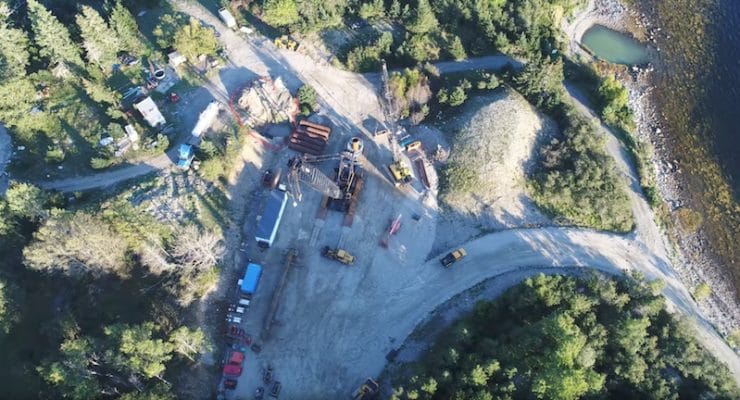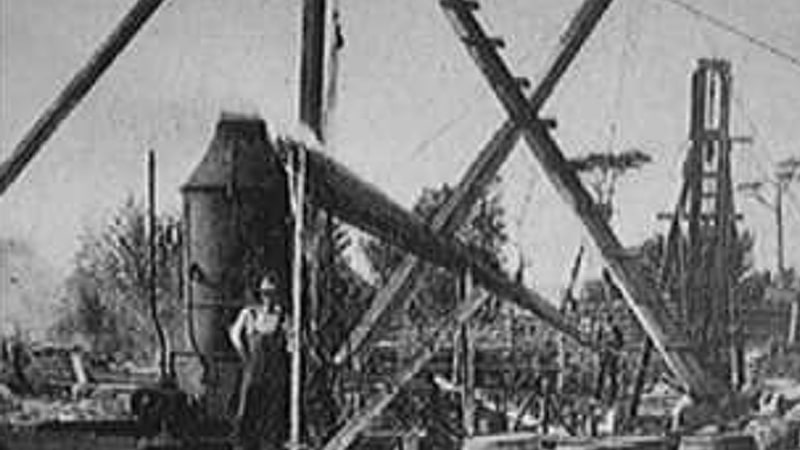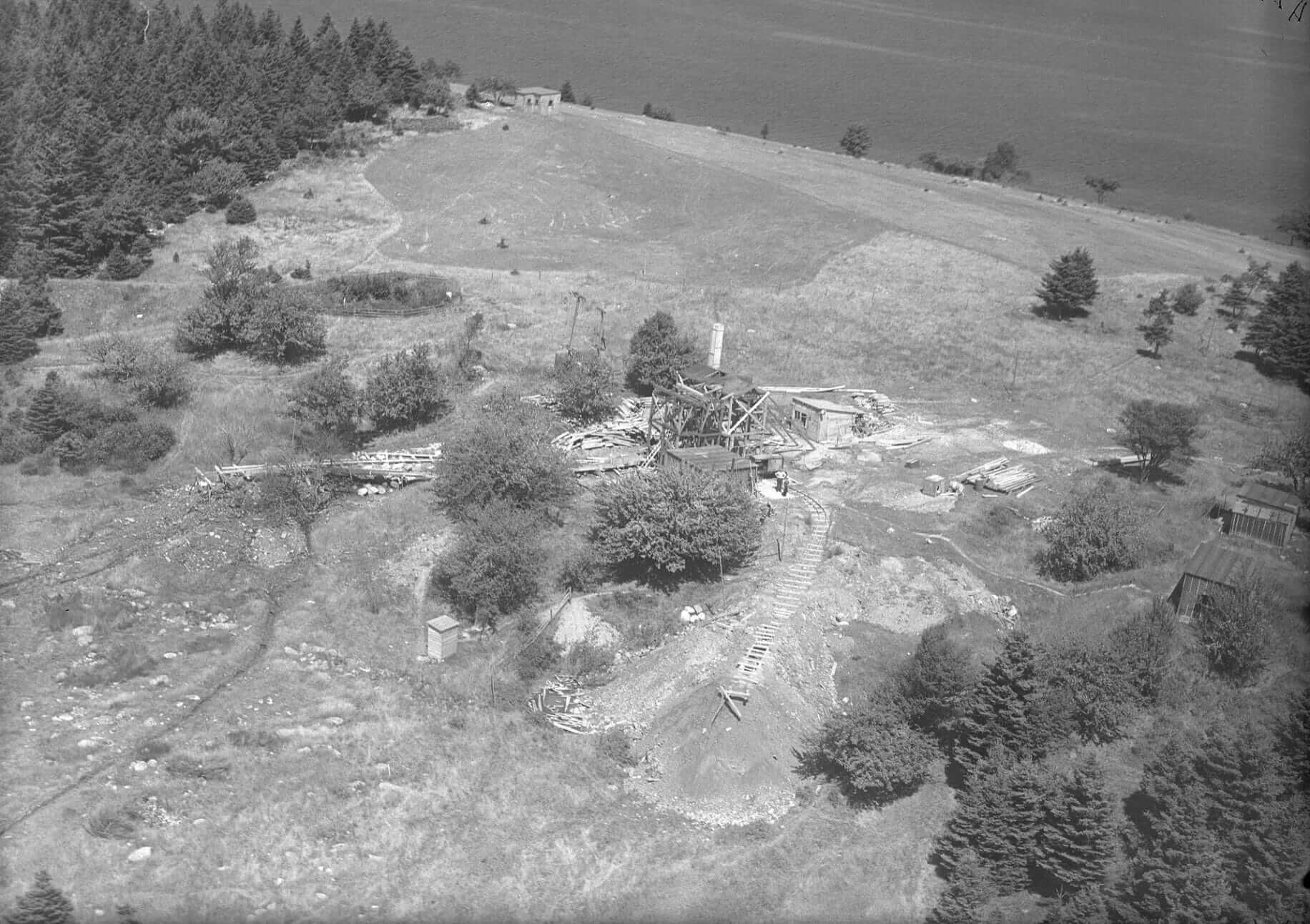
The Money Pit is a name that pricks up the ears of every treasure hunter worth their salt when they hear it mentioned, and has attracted everyone from businessmen to future presidents of the United States.
The origins of the Money Pit date back to around 1795, when a 16-year-old boy called Daniel McInnes from Chester in Nova Scotia is said to have paddled over to Oak Island to look for game to hunt.
The island was uninhabited at the time and as he explored he was surprised to find some features that looked a little out of the ordinary. At one side of the island on a knoll he found a strange depression in the ground. It was about 12 feet across and above it was reportedly hung the tackle-block from a ship.
The boy because excited as even with his limited knowledge of the world he’d still heard legends of the many pirates who are said to have preyed upon the merchant ships of New England.
He decided to get some help and came back the next day with two of his friends. Tony Vaughan and Jack Smith helped McInnes dig down into the depression and after about ten feet they hit a platform made of oak logs. They kept going and at 20 feet they hit more logs and the same again at 30 feet.
As their pit got deeper they could clearly see someone had dug down before them with the clay walls of the excavation covered in pickaxe marks. But as they dug deeper the work became much harder and perhaps started to get a little dangerous. They sought help from others on the mainland but people were superstitious about the island, believing it haunted or cursed after two fisherman went missing in 1720 as they investigated some odd lights they saw on the island.
The trio’s treasure-hunting had to wait another ten years, by which time both Smith and McInnes had set up home on Oak Island. It was 1804 when they were approached by a man of means, also from Nova Scotia, who was very interested in their stories. Simeon Lynds joined up with the pair to form a treasure company to try and get to the bottom of the pit.
They restarted the dig and all the way down to 90 feet they found oak platforms every 10 feet. Intriguingly they also reportedly found various layers of coconut fibre, ship’s putty and charcoal — not to mention a stone with some strange carvings on it, writings that one cryptologist said could mean “Ten feet below, two million pounds are buried.”
Since then, people have speculated that the pit could contain anything from Captain Kidd’s treasure to the Ark of the Covenant and the list of possible Oak Island treasures grows longer every year.
This spurred them on and at just over 90ft they managed to drive a crowbar another five feet into the ground, at which point it struck something solid. They were sure it was a treasure chest but by the time they were ready to dig deeper the pit had flooded, with 60 feet of water covering their hard work and possible prize.
Initially they tried to bale it out but this failed to make an impression on the level of the water and the treasure hunters thought the water was maybe being fed in from an underground stream. They hired more men and dug a nearby shaft to try and intercept with the Money Pit at depth. Disaster struck when just feet from their goal that shaft was also flooded, almost killing some of the men.

By this point Lynds was close to running out of cash and decided to give up and McInnes, whose adventurous spirit had started it all, died soon after.
However, Smith and Vaughan were still smitten with the idea of untold wealth in the pit and in 1849 they formed up with another group of treasure hunters from Truro and began to dig again. Using an auger to sample as it drilled, they found a layer of spruce at 98 feet. Remarkably this was followed by an empty space, then 4 inches of oak, 22 inches of metal, 8 inches of oak, 22 of some sort of loose metal, 4 more of oak, 6 of spruce and then into clay.
This seemed to suggest a vault possibly with a couple of treasure chests placed on top of each other. The auger also brought up a few links of a gold chain and sparked some fever amongst the diggers.
The next year another shaft was dug and at 110ft it also flooded, but one of the men excavating it fell in and noticed the water was salt. Soon after they realised the water was falling and rising with the tides. Vaughan also remembered seeing water running off the island on one of the beaches years before at low tide.
They decided to dig up the whole beach and hidden beneath the sand they found a huge amount of coconut fibre mixed with eel grass spread over a stone floor of some sort. This floor was over 154 feet wide and was augmented by five rock drains that slanted down towards the Money Pit from the shore, seemingly designed to flood it. It was later found that these drains were filled with loose rocks to stop the clay filling them up over time.
The treasure hunters were amazed by this development but were also determined to overcome it. They built a cofferdam to try and hold back the water but it proved no match for the sea. Next they tried digging right underneath the Money Pit but again their plans were thwarted when the pit seemed to fall into a tunnel and then an even bigger mysterious space.

By this time the syndicate had lost a fortune, to the tune of $40,000, and with nothing to show for it. What they did get was a lot of media attention and the legend of the Money Pit began to grow far and wide. This attracted numerous other treasure seekers, all with cunning plans to unlock the secrets and fortunes of the pit.
Tragically and perhaps inevitably all this enterprise led to someone dying and one man was killed when a steam pump being used at the site exploded. The amount of cash being poured into the Money Pit also increased vastly.
One company, run by businessman Frederick Blair, decided to try and block the flood tunnel at the shore using dynamite. They then put dye in the hole to check they’d managed to seal it up. This test proved they had, but unfortunately for them it also uncovered the existence of another flood tunnel head out to the other side of the island, where the dye was found in three places.
This led them to start drilling down into the pit and at 153ft they are said to have hit half a foot of cement followed by five inches of oak and then 2 feet of mixed metal with more wood and cement after that. At the very bottom they hit iron and their drill could not get past it.
However, they did bring up some tiny bits of gold and also some parchment with the letter “vi” written in India ink. Despite these tantalising tasters the company then ran out of money, having spent over $100,000 — a huge sum at the time.
Undeterred by the lack of cash, Blair continued his search and bought up rights to seek treasure on Oak Island for 40 years. Ever the businessman, he then leased parts of the island out in exchange for a cut of any treasure found.
This is where a future president appears in the island’s already colorful history. One of the men taking up the offer of a lease was an engineer named Harry Bowdoin, he hailed from New York and had several backers for his company the Old Gold Salvage Group, including a lawyer who was none other than Franklin D. Roosevelt.
Despite his best efforts and a lot of drilling, Bowdoin came up empty handed and soon became quite disillusioned by the whole enterprise, writing an article claiming there was no treasure at all.
Many other treasure seekers followed with tens of thousands being thrown at the project. It was indeed becoming a very real money pit as fortunes were spent trying to get at the wealth supposed to be lying beneath the unassuming island. William Chappel, who’s drill had brought up the parchment, put another $30,000 in but the crash of the 1930s put an end to his endeavours.
In 1936 a millionaire, Gilbert Hedden, set up power cables from the mainland and used these to power very fast pumps to help the mining firm he’d hired to clear out the pit. They succeeded but he soon came to the conclusion that all the previous activity had probably moved the treasure some distance, maybe as much as 100 feet.
In 1951 Blair died and William Chappel’s son used the opportunity to buy up the island and treasure rights. He tried his own dig but this soon flooded and became more of a pond than a shaft. Like his father, he ended up leasing out his rights to various other wealth seekers.

1959 saw former-steelworker Robert Restall move his whole family to the island where he managed to clear out some of the old shafts and tried to find the flood tunnels that were foiling all attempts to unearth the treasure of Oak Island.
Tragically in 1965 they were trying to seal up what they thought was a drain when Restall was overcome with fumes from an engine they were using. His son Robert Restall Jr. followed him down but he also fell victim to the fumes, with others then heading down to try and save them. In total four people — Robert, his son Bobby, Karl Graeser and Cyril Hiltz — died in the tragedy.
Meanwhile, another man had leased part of the island and brought in a huge crane. Robert Dunfield used a 70-ton crane with a clam bucket to go down to a depth of 134 feet and to a width of 100 feet. He had to build a massive causeway to the island from the mainland and yet despite the huge hole he had dug, nothing was found.
By 1967 we come to an era where fans of The Curse of Oak Island will recognise many of the names. It was then that Daniel C. Blankenship formed another syndicate with Fred Nolan, David Tobias and Robert Dunfield. This was followed by Blankenship and Tobias creating Triton Alliance, having bought up most of the island.
In 1971 they drilled down 235 feet , creating a shaft now known as Borehole 10-X. They then lowered down some cameras and claimed to have found a cave that contained what could be chests, bones and various tools. Sadly the photos proved inconclusive and the shaft soon collapsed and it was not until Season 3 of The Curse of Oak Island that divers managed to explore the shaft, though they found nothing as remarkable as chests or human remains.
By the 1980s the main interest in the Money Pit seemed to have shifted to tourists and there were various legal disputes over access to the island and use of the causeway. Not much exploration was carried out over the next 20 years and in 2005 a large part of the island went up for sale.
In 2006 brothers Rick and Marty Lagina — who had previously been to the island in the 1990s — finally fully arrived on the scene and completed their purchase of what was David Tobias’s more or less 50 per cent share in Oak Island Tours Inc., with Blankenship retaining ownership of the rest. In 2011 the Nova Scotia local government created the Oak Island Treasure Act, allowing the treasure hunt to continue under certain restrictions.
From that point History Channel’s TV show The Curse of Oak Island has tracked the many trials and tribulations of the Laginas as they have tried to unlock the secrets of the Money Pit once and for all.
Due to all the drilling and other work that has taken place over the years — and with accurate records of exactly what that work entailed being hard to come by — the actual location of the original Money Pit has been unknown for many years. However, it’s believed the Laginas finally find it in The Curse of Oak Island Season 5.
The Curse of Oak Island airs Tuesdays at 9/8c on History.
ncG1vNJzZmivp6x7rrvNrKueqqOWu6Wv0aKropujY7CwuY6trWivmJbBtHnToZxmq6Skv7p5wZ6foqaUYsGpsYympqedqWK9qsCMqKVmrJiaeqTB0aycZqeWYryit4yiqqWZnpl8